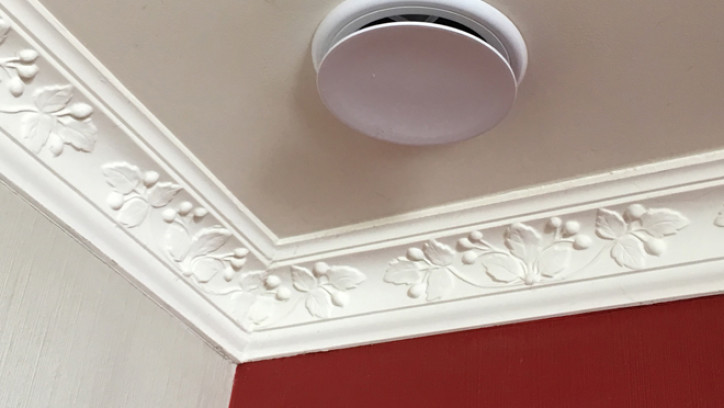Active ventilation
Last updated: 9 August 2023

Active ventilation is mechanically driven and essential in rooms where moisture is generated.
How active ventilation works
Active ventilation is ventilation provided mechanically – for example, by extractor fans, range hoods and whole house ventilation systems. These systems run on electricity – the bigger the system and the more components, the more power it will use.
Active ventilation is essential for rooms where extra moisture is generated (bathroom, laundry and kitchen), while passive ventilation may be sufficient for maintaining air quality through the rest of your home, provided you are diligent with opening windows regularly throughout the day.
Modern airtight homes benefit from whole-house mechanical ventilation to ensure enough ventilation (but not too much) takes place.
Heating your home has more information.
Extractor fans/rangehoods
Extractor fans quickly remove moist air from bathrooms, toilets and laundries. Rangehoods do the same job for kitchens. If your house is very airtight, you may need to open a window on the opposite side of the house a little to let the extractor fans work properly.
It's important to choose the right-sized fan for the job. A fan that's too small won't remove enough moist air to keep your home dry. A fan that's too large can create draughts. For a typical bathroom or toilet, a ventilation rate of 25 litres per second should suffice. Keep the length of ducting as short as you can and avoid sharp bends.
Extractor fans should be placed as close to the moisture source as possible. They must be vented to the outside or the moist air will end up in your roof space, damaging your insulation and roof structure.
Because extractor fans remove moist air but don't bring in fresh air to replace it, you'll need some other way of getting fresh air into the room. By placing air vents on the opposite side of the room from the extractor fan, or slightly opening doors or windows, you can encourage air flow.
To avoid uncomfortable draughts and heat loss while not in use, extractor fans and rangehoods should have backdraught shutters installed with their ducting.
Whole house ventilation systems
For most indoor spaces the Building Code requires openable windows or other openings to the outside, to be at least 5 per cent of the floor area. Otherwise, active mechanical ventilation is required to complement the passive ventilation.
Whole house ventilation systems can be useful to bring in fresh air and combat condensation in modern airtight houses. There are two main types of whole house ventilation systems:
- positive pressure or roof cavity ventilation systems
- balanced pressure or heat recovery ventilation systems.
Positive pressure or roof cavity ventilation systems
Positive pressure or roof cavity ventilation systems are the most common type available in New Zealand. They bring filtered air from the roof space into the house through a single, or multiple, ceiling vents. This positive pressure forces air to leak out through gaps in the building envelope – particularly around windows and doors. The performance of these systems depends on the sizing of the fans, the distribution of the ceiling vents throughout the house and how airtight your home is.
Most systems are fitted with filters – the quality of the air entering the house depends on whether you regularly change or clean filters.
Ventilation systems should bring fresh air from outside into the house. Roof spaces may be polluted by dust, mould and vermin, or even hazardous particles such as asbestos from asbestos cement roofing or sheet cladding.
The 2016 Mechanised residential ventilation systems report on the BRANZ website stated that roof-sourced systems must not be installed into homes with asbestos roof claddings, and those with such systems should have them deactivated for health reasons.
Most positive pressure ventilation systems can easily be ducted, so that they can bring fresh air from outside into the house. If you already have a positive pressure ventilation system, you can have a duct for outside air supply retrofitted.
Balanced pressure and heat exchange ventilation systems
Balanced pressure and heat exchange ventilation systems are particularly suitable for homes in cooler areas of the country, provided that they are already well heated and reasonably airtight.
These systems have two fans: an intake fan that supplies fresh outdoor air into the house through several ceiling vents, and an exhaust fan that takes stale, moist air from inside the house and discharges it to the outside. An air-to-air heat exchanger (usually located in the roof space) transfers heat from the inside air to the incoming fresh air from outside during the cooler parts of the year. In this way, some of the heat is recovered, reducing your space heating bill. Ducting should be well-insulated, and ideally located inside the home's thermal envelope. Locating ducts in a roof space may be convenient, but will result in higher heat losses, reducing the heat recovery effectiveness.
To ventilate effectively, these systems need outlets in multiple rooms, and gaps or vents in internal doors, so air can flow through all areas of the house between the intake and exhaust. To be effective, the house should be quite airtight so that almost all ventilation air passes through the heat exchanger, rather than being leaked out through draughts. The effectiveness of the system depends on the occupants operating and maintaining them correctly.